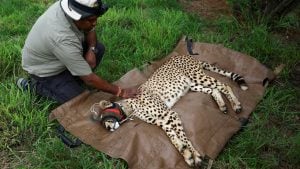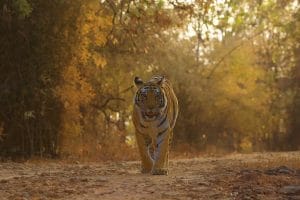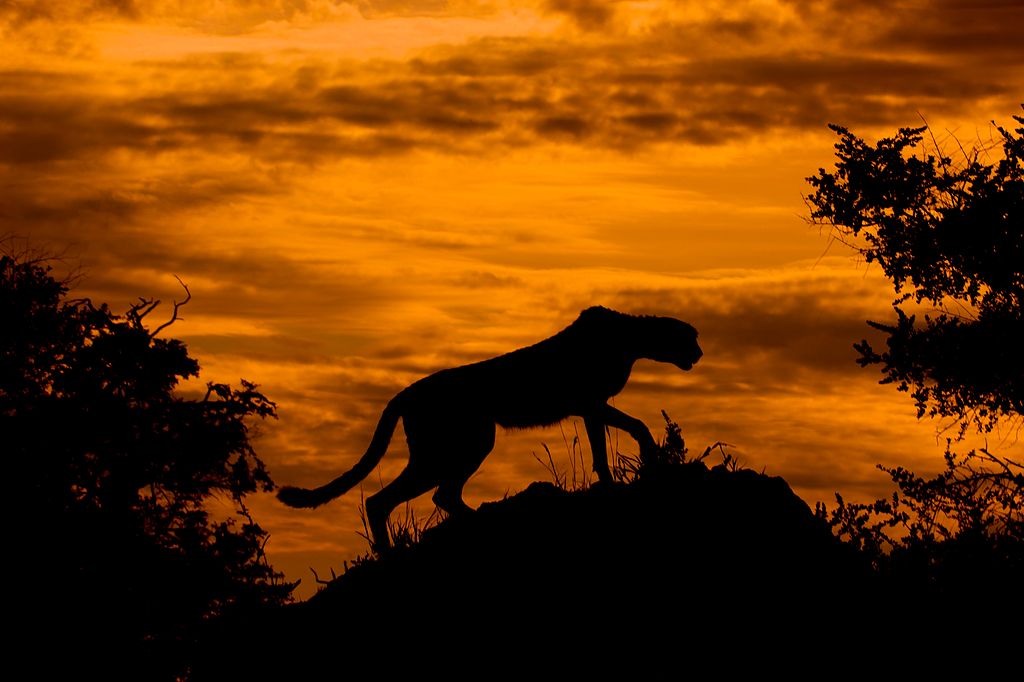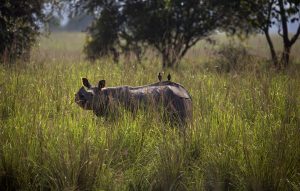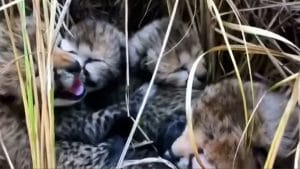Bandhavgarh with Samode Safari — a breathtaking journey from jungle rhythms to tribal traditions

KV Prasad Jun 13, 2022, 06:35 AM IST (Published)
 Listen to the Article (6 Minutes)
Listen to the Article (6 Minutes)
Summary
About four hours’ drive from Jabalpur along the winding roads through Madhya Pradesh’s remote landscapes led me to Bandhavgarh Tiger Reserve. On this seemingly long journey, I traversed a picturesque panorama of expansive rice and wheat paddies, as well as fields teeming with masoor, chana, and the green pods of kutki. Herders, with their weathered faces and seasoned …
Continue reading “Bandhavgarh with Samode Safari — a breathtaking journey from jungle rhythms to tribal traditions”
About four hours’ drive from Jabalpur along the winding roads through Madhya Pradesh’s remote landscapes led me to Bandhavgarh Tiger Reserve. On this seemingly long journey, I traversed a picturesque panorama of expansive rice and wheat paddies, as well as fields teeming with masoor, chana, and the green pods of kutki.
Herders, with their weathered faces and seasoned hands, guided their precious cattle towards the verdant grazing grounds. And amidst patches of golden flower fields, a silent ballet unfolded where the camaraderie of ramdana and mustard seeds (sarson) flourished harmoniously.
I arrived at Samode Safari Lodge, a 22-acre luxury resort in the Umariya district, at the stroke of noon after descending a quiet trail flanked by Sal, Jamun, Awala, and Mahua trees. In this verdant oasis, a dozen villas radiate rustic elegance, encircling the main lodge like a string of pearls, and onto their private verandah, a panorama of natural beauty whispers secrets of the wild.

Once the exclusive game reserve of the Maharajas of Rewa, Bandhavgarh, underwent a significant transformation after independence. In 1965, this area was officially declared a national park, forever etching its name in the hearts of nature enthusiasts.
While the National Park derives its name from the 2000-year-old Bandhavgarh Fort, shrouded in the enigmatic veil of time, within the depths of these dense forests, it is the regal tigers that truly command the spotlight.
Rawal Yadavendra Singh, a royal descendant and the co-owner of Samode Hotels tells me; “The Indian aristocracy had gained a well-deserved reputation for their opulent hunting escapades that often served the dual purpose of sport and social prestige, unwittingly placing the species they pursued in peril.”

However, a profound shift in perspective took hold as “we came to recognise the declining wildlife populations and the imminent risk of losing these magnificent creatures,” says he.
This transformation wasn’t solely a result of a change of heart but also stemmed from a growing affection for the forests and their habitats. The Samode family has consistently prioritised the preservation of their inherited legacy, which includes culture, natural heritage, and progress for their people.
“While my brother and I have made efforts to safeguard our heritage and culture in Rajasthan, we felt compelled to make a positive impact in the Central Indian jungles that held a special place in our hearts,” adds Singh.
The following day, as the sun began to cast a golden glow over the savannah, the engines roared to life, and we set off on a thrilling game drive in a customised 4×4 off-road Samode safari jeep into the untamed wilderness of Bandhavgarh. The forest is divided into three zones: Tala, Magadhi, and Khitauli. We covered each zone on separate days, where the rustling foliage and dancing rays of sunlight conspired to weave an ambience brimming with anticipation.
Tala was the first zone we ventured into, where we first drove uphill to the base of the Bandhavgarh Fort to catch a glimpse of the Sheshshaiya statue of Lord Vishnu reclining on the seven-hooded serpent Sheshnaag. The fort, spanning an impressive ten floors, holds within its walls a collection of reclining statues depicting various Vishnu avatars. Time has taken its toll on the fort, which now remains off-limits to visitors, except for Janmashtami, when the government makes an exception and allows devotees to ascend the hill to pay their respects at the Krishna temple.

For nearly three hours, we traversed rugged terrains, guided by Anshuman Shah, GM of Samode Safari Lodge and an expert ranger who shared his wealth of knowledge about the wildlife that calls this place home. The Egyptian vulture soared high above, a majestic silhouette against the setting sun. The yellow-crowned woodpecker, with its vibrant plumage, pecks away at the trees, creating a symphony of rhythmic beats. We were predominantly surrounded by the Sal forest, adorning the valleys and lower slopes. However, as we ascended further, the landscape became a blend of Dhobin,
Saja, Salai, and countless other trees. The skies were painted with a kaleidoscope of colours, different types of butterflies fluttered delicately, and reptiles, slithering on the ground, added mystery to the tapestry of life. Stretching as far as the eye can see, wide valleys, carved by meandering streams, boast long, linear grasslands. In this dramatic symphony of nature, melodious calls of the painted Francolin, the resplendent Junglefowl, and the Indian Peafowl further heighten your senses. The whistling duck and the Turnicidae serenade you with their enchanting tunes, while the Barred Buttonquail leaves you in awe of its intricate beauty. But the avian wonders do not end there.
Amidst this spectacle, Anshuman, my vigilant guide, ever watchful, scans the path for any trace of tiger paw marks, yearning for a fleeting encounter with the elusive predator. Most animals, especially tigers, are creatures of habit. They have a regular patrolling pattern and are partial to their favourite haunts. Samode Safari keeps track of these movements by checking the spoor of the tigers and listening to the alarm calls of animals, substantially increasing the chances of spotting. We encountered Gaur and barking deer, among a plethora of other fascinating creatures in Tala zone.
However, it was on the third day, during our third safari at Magadhi, that we were blessed with a crystal-clear sighting of the majestic 8th-generation tigress, Dotty.
Bandhavgarh is a haven not only for the mighty tiger, but also for panthers, sloth bears, wolves, leopard, chital, sambhar, hyenas, and wild dogs.

As twilight descends, the collared Scops Owl emerges, its haunting hoot echoing through the night. And amidst the foliage, the Racket-tailed Drongo, with its sleek ebony feathers, commands attention with its swift and agile flight. Even at the Samode Safari Lodge, one can often catch a glimpse of this mischievous Drongo, expertly imitating its avian companions.
The in-house spa offers a marvellous refuge to alleviate any post-safari fatigue. I was pampered by Vanka, my skilled therapist, who treated me to a 60-minute Aromatherapy session with the invigorating essence of Eucalyptus oil. The spa started with a cup of honey lemon tea served with a cinnamon stick and conclude with a chamomile tea with a handful of nuts on the side.
For those who’d prefer to skip the spa, Samode offers a pleasant alternative: a footbath brimming with steaming water and fragrant rose petals, awaiting you upon your return from the rousing game drive.
Bandhavgarh, however, transcends the limitations of being just another wildlife sanctuary. The forest region is surrounded by quaint villages, where the Gond tribe, consisting of 108 families, and the Baiga tribe, with only 2 families, have made their homes.
My tryst with these tribes took place in the village of Mardari, where most houses are painted in blue, and the courtyards are decked with stacks of hay, homegrown maize, and dried Mahua flowers. A picturesque sight that truly captures the essence of rural life. The women of the household take charge of their kitchens early at 9 in the morning. On a trusty mud stove (also known as a chulha), they ignite a fiery feast by skilfully kindling wooden sticks. Both tribes share a common love for spices and pulses. However, it’s the subtle nuances that set their cooking apart.

The Baiga tribe, for instance, opts for ground spices to elevate their dishes to new heights. On the other hand, the Gond tribe, prefer to unleash the full potential of whole spices in their gastronomic creations. With their mud stoves ablaze and spices at the ready, they transform humble ingredients into mouth watering meals. Baiga and Gond cuisine is a medley of hearty grains like Kodo millet, kutki, and maize. The community’s go-to thirst quencher is Pej, a refreshing drink made from ground macca or leftover rice water. The mahua flower is used in numerous ways in Baiga cuisine.

During festivals and ceremonies, the Baiga folks whip up a divine Mahua beverage, a fermented drink made from sun-dried flowers. It’s a tradition to offer this nostrum to every guest and relative who graces their humble abode. The Baiga people also sprinkle sun-dried, chopped mahua flowers into their sweet dishes. And the oil extracted from these flowers is used for cooking and by the elders of the community to cure joint pain.
Many of the tribal men toil away in the fields or find gainful employment at the nearby resorts. Both Gond and Baiga tribes have truly embraced the winds of change, opting for houses constructed with sturdy cemented bricks instead of the traditional clay.
However, they haven’t completely abandoned their roots, as the flooring and roof tiles remain earthy, composed of good old mud. Even in this idyllic setting, mischief lurks in the form of mischievous monkeys who have a knack for damaging those precious clay tiles, prompting the villagers to engage in regular maintenance to keep their homes looking spick and span. Every year, three families in the village take on the noble duty of producing roof tiles for the entire community.
The Gond tribe in this region refrains from painting their house walls, as the art form is predominantly executed by skilled artists on a grand scale. Similarly, the Baiga tribe in Mardari and neighbouring villages abstains from tattooing, unlike their rustic counterparts. However, they proudly identify themselves as the offspring of Mother Earth, the enigmatic protectors of this sacred land, immersed in profound wisdom.

Within each household of the Mardari village, lies a kitchen garden. From brinjal to bottle and bitter gourd, and even the fiery chillies, juicy tomatoes, and zesty lemons, their gardens are a trove of flavours. These resourceful tribes also fashion water bottles and lamps out of the versatile bottle gourd. Samode Safari Lodge, too has embraced the customs of the village with open arms. Within its grounds, a kitchen garden flourishes, spanning a generous a 28000 sq. ft.
Here, they cultivate an abundance of vegetables, ensuring a seamless farm-to-fork experience for their esteemed guests. So, whether you find yourself exploring the traditions of the Gond and Baiga tribes or indulging in the culinary delights of Samode Safari Lodge, one thing is certain – the allure of fresh ingredients knows no bounds.
With an impeccable knack for balancing textures and flavours, executive chef, Shafat Hussain, masterfully wields these ingredients to conjure up tantalising cuisines.
“To ensure a seamless dining experience, the lodge offers a set menu that allows them to meticulously plan their culinary creations based on ingredient availability.

However, for those seeking a more interactive adventure, guests are also invited to explore the kitchen garden and handpick their own vegetables. And if that’s not enough, they can even partake in a captivating cooking demonstration, where the secrets of the chef’s artistry are unveiled,” says Shafat Hussain, executive chef of Samode Safari Lodge.
Anshuman adds, “At Samode Safari Lodge, rustic charm meets eco-friendly elegance. As you transit the dirt tracks that wind their way through the villas, you’ll notice the commitment to sustainability at every nook and cranny.”
“From the Alang wooden flooring in the main lodge, exuding warmth and character, to the sturdy brick-and-clay-mortar, we have carefully chosen eco-friendly materials that harmonise with the surrounding environment. Even our clay tile roofing adds a touch of traditional charm to the overall aesthetic. Inside our villas, the furnishings are predominantly crafted from teak and Sal wood, which is both luxurious and sustainable,” Anshuman explained.
The WiFi is exclusively accessible in the main lodge, and it is with great pride that Anshuman proclaims, “We disconnect you from the world and connect you to nature.”
— The author, Veidehi Gite, is a travel journalist with more than a decade of writing experience and a passion for exploring the world. The views and experience narrated in the article is personal.

Elon Musk forms several ‘X Holdings’ companies to fund potential Twitter buyout
3 Mins Read
Thursday’s filing dispelled some doubts, though Musk still has work to do. He and his advisers will spend the coming days vetting potential investors for the equity portion of his offer, according to people familiar with the matter

KV Prasad Journo follow politics, process in Parliament and US Congress. Former Congressional APSA-Fulbright Fellow










 Listen to the Article
Listen to the Article  Daily Newsletter
Daily Newsletter





